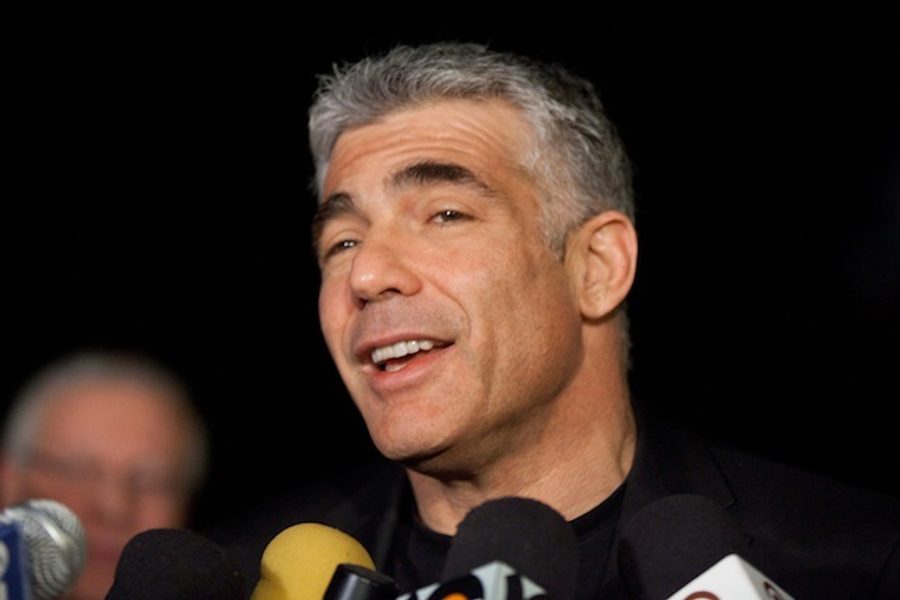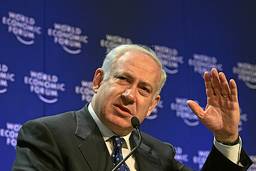In Israel’s Elections, a Star Is Born
After a surprise showing, will centrist Yair Lapid put his new clout behind peace?
Ralph Seliger

On January 22, Israel’s voters surprised Prime Minister Netanyahu and themselves by returning a closely divided Knesset (Israel’s parliament). The balance teetered the day after the election until the final tally of absentee ballots, primarily from soldiers, pushed the needle slightly to the right. Together, the rightwing and ultra-Orthodox parties won 61 seats, while the centrist, leftwing and predominantly Arab parties garnered 59. Now the parties have two months to negotiate a governing coalition.
In all, 12 of 34 competing party lists made it past the 2 percent vote threshold to earn a spot in the Knesset. While Netanyahu-Lieberman’s combined “Likud-Israel Our Home” list emerged with the most seats, at 31, that is 11 fewer than the total when each party ran separately four years ago. Given this, the biggest electoral success story was that of the runner-up, which took 19 seats: the new, centrist There is a Future party led by former celebrity journalist Yair Lapid.
Theoretically, Lapid could pull together a governing coalition of the center-Left and Arab parties, with the addition of one religious Jewish party. But Lapid, in a dismissive remark regarded by some as an anti-Arab slur, has vowed not to be dependent upon predominantly Arab parties, and he has also alienated most ultra-religious Jewish citizens with his number-one campaign demand: to make ultra-Orthodox (haredi) men, who comprise 4-5 percent of the population, “share the burden” of sustaining the country. This would mean ending their exemption from military conscription or demanding they do alternative national service, and halting the subsidies given to 60 percent to do full-time religious study.
The privileges of the haredi were originally secured when the ultra-religious sects were small and thought by Israel’s founding father, David Ben-Gurion, to be on the verge of extinction. Now, according to Shahar Ilan, vice president of Hiddush—an Israeli NGO that works for religious freedom and equality—haredi families average 6.5 children, as compared to 2.3 for other Israeli Jews and 2.8 for Israeli Arabs. Their special status and rapidly expanding numbers are resented by most secular or moderately religious Israeli Jews who see them as burdening the majority. However, haredi political clout — currently manifested by two parties totaling 18 seats in the incoming parliament — has caused governments to fall more than once.
Lapid’s new party is but the latest in a 35-year-tradition of self-described “centrist” movements. In 1977, the Democratic Movement for Change challenged the Labor Zionist parties that ruled during Israel’s first 29 years and instituted the world-famous kibbutzim and the Histadrut union-owned industries. But the Democratic Movement for Change chose to join a coalition with the Right, bringing the first Likud government to power, under Menachem Begin. A linear offshoot, the also-centrist Change party, led by Lapid’s late father, “Tommy” Yosef Lapid, rose to become Israel’s third-largest party in 2003, propelled by a nasty campaign against haredi power, before disappearing ingloriously in 2006.
The most recent “centrist” phenomenon was Kadima (Forward), founded by rightwing Prime Minister Ariel Sharon after much of his own Likud objected to the unilateral withdrawal from Gaza in the summer of 2005. After Sharon’s incapacitating stroke in January 2006, Prime Minister Ehud Olmert took over leadership of Kadima, winning the election in 2006 before being derailed by his own legal difficulties stemming from questionable practices when he was mayor of Jerusalem (forcing his resignation as PM). Then Foreign Minister Tzipi Livni succeeded in leading Kadima to first place in February 2009 only to fail to pull together a coalition government, which allowed Netanyahu to become prime minister. Livni’s uninspiring leadership of Kadima in opposition led to her defeat in the party primary in March 2012; and when her successor meandered into Netanyahu’s government and out of it within ten weeks, Kadima lost most of its remaining support. The younger Lapid’s current rise comes as Kadima has barely survived, with only two members of the new Knesset.
Coalition configurations
There are a host of possible chess moves rumored, such as Lieberman decoupling his party’s 11 seats from Likud to maximize his bargaining power, which would leave Netanyahu to begin the coalition-building process with the numerically smallest parliamentary faction (20) of any likely governing party in Israel’s 64-year history. That is, assuming that Lapid’s list does not emerge as larger, due to other possibilities in play, such as Tzipi Livni’s new center-left, peace-oriented party adding its six seats to Lapid’s 19.
The most likely scenario involves Netanyahu as head of a wobbly coalition consisting of Likud-Israel Our Home at its core, Lapid to his left and Naftali Bennett’s anti-peace process Jewish Home party on his right. This marriage of convenience could adopt some version of Lapid’s “burden-sharing” agenda for the haredim, but virtually nothing regarding peace, which Lapid also claims as a priority. If Lapid holds fast to his stated commitment to renewing peace talks, which is what his dovish running mates would like, it’s hard to envision such a coalition forming or enduring. Alternately, unless some rightwing or ultra-Orthodox allies defect, Netanyahu could form a narrow majority of the Right and religious parties without Lapid anyway.
Speculation is rampant as to how hard Lapid wants to push a peace agenda. Ha’aretz newspaper columnist Barak Ravid quotes Lapid from a 2008 interview with the German magazine, Der Spiegel, as follows:
The greatest tragedy of the I-P conflict is that we all know how it’s going to end. We are going to divide the land. Israel will give back most of the West Bank and a Palestinian flag will fly over the public buildings in East Jerusalem. The only unanswered question is how many are going to die on the way. We are going to fight against the extremes on both sides, including our settlers.
Lapid’s party platform insists upon retaining East Jerusalem under Israeli rule, a non-starter for the Palestinians and a step back from what both Barak and Olmert had agreed to in their negotiations in 2000 and in 2008. But a party platform is no more binding for Israeli politicians than it is for their U.S. counterparts and can mark a beginning point for negotiations rather than a hard line.
Prospects for the Left
Having depicted the Right and center, what about the Left? The Labor party finished a disappointing third with 15 seats, a mere two-seat gain from 2009. In the recent past, Amiram Mitzna and Amir Peretz fell from this party’s leadership when they hit the then-historic nadir of 19 seats each in 2003 and 2006; both will now rejoin the Knesset on Livni’s list. Shelly Yachimovich, Labor’s current leader, who even denies that the party is traditionally leftwing, may also soon pay the price of failed expectations.
In the meantime, Zehava Gal-On has won praise for leading Meretz back from the verge of extinction at three seats to six (almost seven). A joint list next time of Meretz with the Democratic Front for Peace and Equality, known as Hadash, would seem to make sense. The two parties share views on most issues, advocating a negotiated two-state solution and equal rights for Israel’s Arab citizens. In some ways, Meretz and Hadash are mirror images: Meretz has one newly elected Arab Member of Knesset and draws mostly Jewish votes, while Hadash has one Jewish MK (Dov Khenin) among its four and relies mostly on the votes of Israeli Arabs.
In a post-election conference call with Meretz leader Gal-On, sponsored by Partners for Progressive Israel, I asked about the prospect of a joint list with Hadash. While noting her respect for Hadash’s Khenin and her hopes for continued cooperation, she ruled out the possibility, citing their philosophical differences. Meretz has also categorically rejected joining a coalition with Netanyahu, but is not likely to be invited, despite Gal-On’s prediction that with Israel’s looming 10 billion dollar deficit necessitating some painful budget cuts, Netanyahu will want as large a coalition as he can manage.
Gal-On is not optimistic about the near-term prospects for peace, partly because she doesn’t trust Netanyahu’s willingness to make a reasonable deal with Abbas for two states, but also because his party is more hardline than it used to be. Moreover, she doesn’t know how much of his new political capital Lapid is willing to spend for the sake of peace.
A key difference between Meretz and Labor this time—aside from a Meretz campaign that explicitly embraced its leftist image—is that Labor under Yachimovich emphasized only socioeconomic issues, ignoring questions of peace and security. Gal-On believes that these matters are inseparable, because of the vast expenditures made by Israel in the Occupied Territories.
After much media angst about a vapid campaign and apathetic electorate, the national voter turnout actually increased from about 65 percent to 68 percent. Arab turnout also increased, from 53 percent to 56 percent. If Arabs voted in the same proportion as Jewish Israelis, however, the dovish bloc would be strengthened. In fact, the Israeli peace camp weakens itself by not mobilizing the voting capacity of Israeli Arabs, which would likely entail offering one or more majority-Arab parties a role in governing coalitions. But this would have to be an issue for next time, a maximum of four years from now — or sooner, if the governing coalition is as unstable as it’s likely to be.








